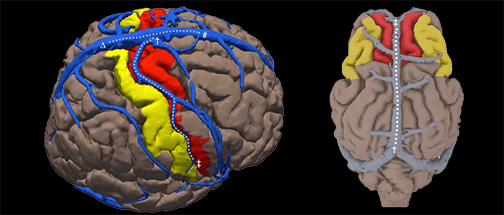Stent-electrode array for cortical neural activity
Minimally invasive endovascular stent-electrode array for high-fidelity, chronic recordings of cortical neural activity
This news has been contributed by Assoc. Prof. Bradford Moffat of the Melbourne Brain Centre Imaging Unit, Department of Radiology and Medicine, The University of Melbourne, Parkville.
National Imaging Facility Fellow, Assoc. Prof. Bradford Moffat collaborated with Dr. Tom Oxley’s group at the University of Melbourne for this high profile publication[1] that appeared in the journal “Nature Biotechnology”.
High-fidelity intracranial electrode arrays for recording and stimulating brain activity have facilitated major advances in the treatment of neurological conditions over the past decade. Traditional arrays require direct implantation into the brain via open craniotomy, which can lead to inflammatory tissue responses, necessitating the development of minimally invasive approaches that avoid brain trauma. Here we demonstrate the feasibility of chronically recording brain activity from within a vein using a passive stent-electrode recording array (stentrode). We achieved implantation into a superficial cortical vein overlying the motor cortex via catheter angiography and demonstrate neural recordings in freely moving sheep for up to 190 d. Spectral content and bandwidth of vascular electrocorticography were comparable to those of recordings from epidural surface arrays. Venous internal lumen patency was maintained for the duration of implantation. Stentrodes may have wide-ranging applications as a neural interface for treatment of a range of neurological conditions. The following figures are representative images that appear in the article and were generated from data acquired on the 7T MRI scanner at the University of Melbourne node of NIF.


This technology has been licensed by Synchron and is in currently undergoing a first in man clinical trial (https://www.synchronmed.com/stentrode/). For further information, the interested reader is pointed to our full publication which can be accessed at (http://dx.doi.org/10.1038/nbt.3428).
References
- Oxley, T.J., N.L. Opie, S.E. John, G.S. Rind, S.M. Ronayne, T.L. Wheeler, J.W. Judy, A.J. McDonald, A. Dornom, T.J.H. Lovell, C. Steward, D.J. Garrett, B.A. Moffat, E.H. Lui, N. Yassi, B.C.V. Campbell, Y.T. Wong, K.E. Fox, E.S. Nurse, I.E. Bennett, S.H. Bauquier, K.A. Liyanage, N.R. van der Nagel, P. Perucca, A. Ahnood, K.P. Gill, B. Yan, L. Churilov, C.R. French, P.M. Desmond, M.K. Horne, L. Kiers, S. Prawer, S.M. Davis, A.N. Burkitt, P.J. Mitchell, D.B. Grayden, C.N. May, and T.J. O’Brien. ‘Minimally invasive endovascular stent-electrode array for high-fidelity, chronic recordings of cortical neural activity’, Nat Biotech, 2016.




